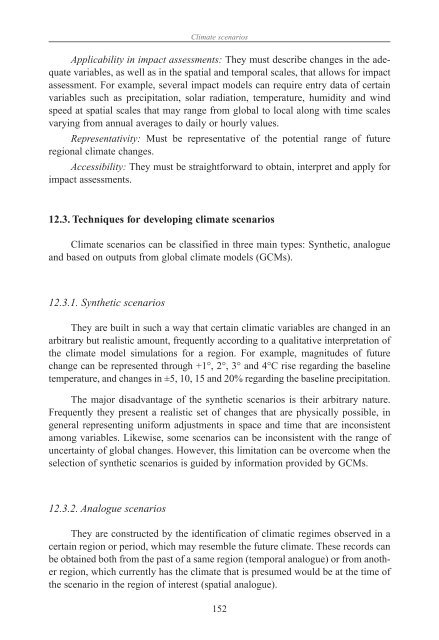chapter - Atmospheric and Oceanic Science
chapter - Atmospheric and Oceanic Science
chapter - Atmospheric and Oceanic Science
Create successful ePaper yourself
Turn your PDF publications into a flip-book with our unique Google optimized e-Paper software.
Applicability in impact assessments: They must describe changes in the adequate<br />
variables, as well as in the spatial <strong>and</strong> temporal scales, that allows for impact<br />
assessment. For example, several impact models can require entry data of certain<br />
variables such as precipitation, solar radiation, temperature, humidity <strong>and</strong> wind<br />
speed at spatial scales that may range from global to local along with time scales<br />
varying from annual averages to daily or hourly values.<br />
Representativity: Must be representative of the potential range of future<br />
regional climate changes.<br />
Accessibility: They must be straightforward to obtain, interpret <strong>and</strong> apply for<br />
impact assessments.<br />
12.3. Techniques for developing climate scenarios<br />
Climate scenarios can be classified in three main types: Synthetic, analogue<br />
<strong>and</strong> based on outputs from global climate models (GCMs).<br />
12.3.1. Synthetic scenarios<br />
They are built in such a way that certain climatic variables are changed in an<br />
arbitrary but realistic amount, frequently according to a qualitative interpretation of<br />
the climate model simulations for a region. For example, magnitudes of future<br />
change can be represented through +1°, 2°, 3° <strong>and</strong> 4°C rise regarding the baseline<br />
temperature, <strong>and</strong> changes in ±5, 10, 15 <strong>and</strong> 20% regarding the baseline precipitation.<br />
The major disadvantage of the synthetic scenarios is their arbitrary nature.<br />
Frequently they present a realistic set of changes that are physically possible, in<br />
general representing uniform adjustments in space <strong>and</strong> time that are inconsistent<br />
among variables. Likewise, some scenarios can be inconsistent with the range of<br />
uncertainty of global changes. However, this limitation can be overcome when the<br />
selection of synthetic scenarios is guided by information provided by GCMs.<br />
12.3.2. Analogue scenarios<br />
Climate scenarios<br />
They are constructed by the identification of climatic regimes observed in a<br />
certain region or period, which may resemble the future climate. These records can<br />
be obtained both from the past of a same region (temporal analogue) or from another<br />
region, which currently has the climate that is presumed would be at the time of<br />
the scenario in the region of interest (spatial analogue).<br />
152






